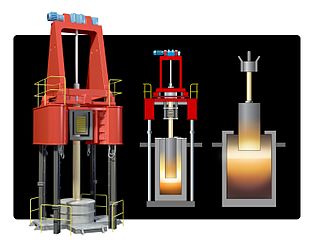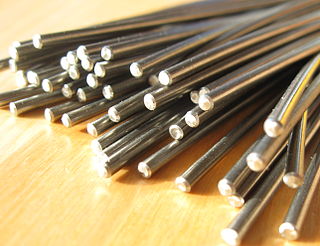Related Research Articles

Brazing is a metal-joining process in which two or more metal items are joined together by melting and flowing a filler metal into the joint, with the filler metal having a lower melting point than the adjoining metal.
Refractory metals are a class of metals that are extraordinarily resistant to heat and wear. The expression is mostly used in the context of materials science, metallurgy and engineering. The definition of which elements belong to this group differs. The most common definition includes five elements: two of the fifth period and three of the sixth period. They all share some properties, including a melting point above 2000 °C and high hardness at room temperature. They are chemically inert and have a relatively high density. Their high melting points make powder metallurgy the method of choice for fabricating components from these metals. Some of their applications include tools to work metals at high temperatures, wire filaments, casting molds, and chemical reaction vessels in corrosive environments. Partly due to the high melting point, refractory metals are stable against creep deformation to very high temperatures.
Induction heating is the process of heating electrically conductive materials like metals by electromagnetic induction, through heat transfer passing through an induction coil that creates an electromagnetic field within the coil to melt down steel, copper, brass, graphite, gold, silver, aluminum, and carbide. An induction heater consists of an electromagnet and an electronic oscillator that passes a high-frequency alternating current (AC) through the electromagnet. The rapidly alternating magnetic field penetrates the object, generating electric currents inside the conductor, called eddy currents. The eddy currents flow through the resistance of the material, and heat it by Joule heating. In ferromagnetic and ferrimagnetic materials, such as iron, heat also is generated by magnetic hysteresis losses. The frequency of the electric current used for induction heating depends on the object size, material type, coupling and the penetration depth.

A heating element converts electrical energy into heat through the process of Joule heating. Electric current through the element encounters resistance, resulting in heating of the element. Unlike the Peltier effect, this process is independent of the direction of current.

An electric arc furnace (EAF) is a furnace that heats material by means of an electric arc.
Heraeus is a German technology group with a focus on precious and special metals, medical technology, quartz glass, sensors and specialty light sources. Founded in Hanau in 1851, the company is one of the largest family-owned companies in Germany in terms of revenue. Heraeus employs approximately 16,200 people in 40 countries worldwide and generated a total revenue of 29.5 billion euro in 2021.

A foundry is a factory that produces metal castings. Metals are cast into shapes by melting them into a liquid, pouring the metal into a mold, and removing the mold material after the metal has solidified as it cools. The most common metals processed are aluminum and cast iron. However, other metals, such as bronze, brass, steel, magnesium, and zinc, are also used to produce castings in foundries. In this process, parts of desired shapes and sizes can be formed.
An induction furnace is an electrical furnace in which the heat is applied by induction heating of metal. Induction furnace capacities range from less than one kilogram to one hundred tons, and are used to melt iron and steel, copper, aluminum, and precious metals.

Electroslag remelting (ESR), also known as electro-flux remelting, is a process of remelting and refining steel and other alloys for mission-critical applications in aircraft, thermal power stations, nuclear power plants, military technology and others.

Investment casting is an industrial process based on lost-wax casting, one of the oldest known metal-forming techniques. The term "lost-wax casting" can also refer to modern investment casting processes.
Spray forming, also known as spray casting, spray deposition and in-situ compaction, is a method of casting near net shape metal components with homogeneous microstructures via the deposition of semi-solid sprayed droplets onto a shaped substrate. In spray forming an alloy is melted, normally in an induction furnace, then the molten metal is slowly poured through a conical tundish into a small-bore ceramic nozzle. The molten metal exits the furnace as a thin free-falling stream and is broken up into droplets by an annular array of gas jets, and these droplets then proceed downwards, accelerated by the gas jets to impact onto a substrate. The process is arranged such that the droplets strike the substrate whilst in the semi-solid condition, this provides sufficient liquid fraction to 'stick' the solid fraction together. Deposition continues, gradually building up a spray formed billet of metal on the substrate.
Fusible core injection molding, also known as lost core injection molding, is a specialized plastic injection molding process used to mold internal cavities or undercuts that are not possible to mold with demoldable cores. Strictly speaking the term "fusible core injection molding" refers to the use of a fusible alloy as the core material; when the core material is made from a soluble plastic the process is known as soluble core injection molding. This process is often used for automotive parts, such as intake manifolds and brake housings, however it is also used for aerospace parts, plumbing parts, bicycle wheels, and footwear.

Nickel titanium, also known as Nitinol, is a metal alloy of nickel and titanium, where the two elements are present in roughly equal atomic percentages. Different alloys are named according to the weight percentage of nickel; e.g., Nitinol 55 and Nitinol 60. It exhibits the shape memory effect and superelasticity at different temperatures.
Electron-beam additive manufacturing, or electron-beam melting (EBM) is a type of additive manufacturing, or 3D printing, for metal parts. The raw material is placed under a vacuum and fused together from heating by an electron beam. This technique is distinct from selective laser sintering as the raw material fuses having completely melted.
Vacuum arc remelting (VAR) is a secondary melting process for production of metal ingots with elevated chemical and mechanical homogeneity for highly demanding applications. The VAR process has revolutionized the specialty traditional metallurgical techniques industry, and has made possible tightly-controlled materials used in biomedical, aviation and aerospace.
The filler metal (FM) alloys that can be produced as amorphous brazing foils (ABF) are eutectic compositions formed by transition metals such as nickel, iron, copper, etc., in combination with metalloids, such as silicon, boron and phosphorus. In conventional crystalline state, all these materials are inherently brittle and cannot be produced in continuous forms such as foil, wire, etc. Therefore, they were available only as powders, pastes, or their derivates. On the other hand, the very presence of metalloids at or near the eutectic concentration promotes the rapid solidification (RS) conversion of such alloys into a ductile amorphous foil.
Induction brazing is a process in which two or more materials are joined together by a filler metal that has a lower melting point than the base materials using induction heating. In induction heating, usually ferrous materials are heated rapidly from the electromagnetic field that is created by the alternating current from an induction coil.

Mishra Dhatu Nigam Limited, is a specialized metals and metal alloys manufacturing facility in India, located in Hyderabad, Telangana. It is a Public Sector Undertaking (PSU), under the administrative control of Department of Defence Production, Ministry of Defence, Government of India. MIDHANI is the only producer of Titanium in India.

Selective laser melting (SLM) is one of many proprietary names for a metal additive manufacturing (AM) technology that uses a bed of powder with a source of heat to create metal parts. Also known as direct metal laser sintering (DMLS), the ASTM standard term is powder bed fusion (PBF). PBF is a rapid prototyping, 3D printing, or additive manufacturing technique designed to use a high power-density laser to melt and fuse metallic powders together.
USAF-96 is a high-strength, high-performance, low-alloy, low-cost steel, developed for new generation of bunker buster type bombs, e.g. the Massive Ordnance Penetrator and the improved version of the GBU-28 bomb known as EGBU-28. It was developed by the US Air Force at the Eglin Air Force Munitions Directorate. It uses only materials domestic to the USA. In particular it requires no tungsten.
References
- 1 2 Mühlbauer, Alfred (2008). History of Induction Heating and Melting. ISBN 978-3-8027-2946-1.
- 1 2 "Vacuum Induction Melting and Casting". azom.com. 4 July 2002.
- ↑ Patent DE 345161, Vacuumschmelze and Dr. Wilhelm Rohn, Verfahren zum Vakuumschmelzen und Vergueten von Metallen und Legierungen, priority date 12 January 1918, published 12 June 1921.
- 1 2 "Consarc | Vacuum Induction Melting". Archived from the original on 2012-04-25. Retrieved 2011-10-04.
- 1 2 http://md1.csa.com/partners/viewrecord.php?requester=gs&collection=TRD&recid=8512511577MD&q=vacuum+induction+melting&uid=792184177&setcookie=yes%5B%5D
- ↑ Casting , Vacuum Induction Melting. ASM Handbook. Vol. 15. 2008. ISBN 978-0-87170-711-6.